Unbound tech roundtable: The best gravel tire and the gear we’d bring
This article originally appeared on Velo News
Unbound Gravel is not only a test of your endurance and mental fortitude but the gear you’re using too.
Whether you’re looking to race in something like Unbound Gravel or simply finish, using the right tools will make your ride just a little easier. The only problem? There’s hardly ever a consensus on what gear to bring. That’s where we come in.
What’s the best tire for Unbound Gravel? Should I carry a hydration pack for gravel? Wait, should I bring a paint stick? Troy Templin, Will Tracy, Betsy Welch, and I (Alvin Holbrook) dive into some of the most-asked questions about what is the ‘Super Bowl of gravel.’
Read more: Event preview: 2023 Unbound Gravel
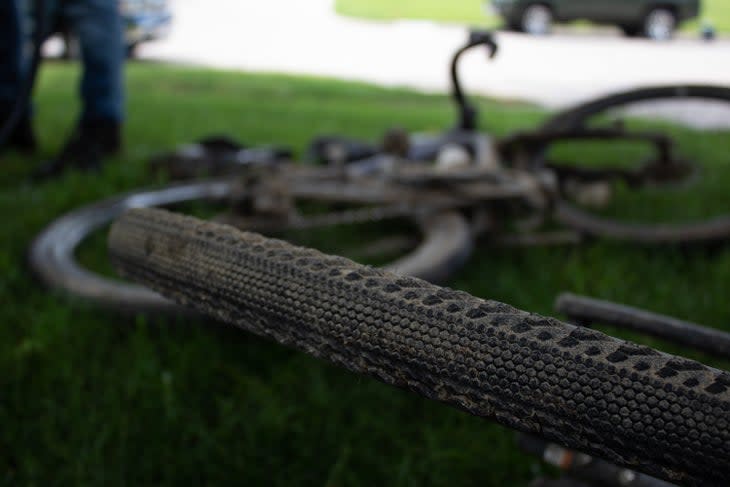
What is the best tire for Unbound?
Troy Templin (Senior tech editor): This might be the most asked question for those that are lucky enough to get an entry to the event. I jokingly say, “The one that doesn’t get a flat.” In reality, it changes every year depending on the conditions. What I would say is always leave room for lots of mud. You never know when the weather might change, and if your tire has no room for mud, it will be an even longer day, if not impossible. Walking takes a lot longer than slow rolling.
The other thing I like to remind riders is that you need to balance risk vs. reward. Sure, a 30-50 gram lighter tire might be nice, but there is a lot of terrain to cover, and making sure your tire matches your goal is key. Don’t sacrifice durability and the amount of rubber or protection. Changing flat tires takes time, lots more time than rolling a bit slower or moving the extra weight. Not to mention that if you get a flat, you will no longer be riding with riders at the same pace and goal time as you. They will likely be on track for a slower pace, meaning you will be the one leading the pace most of the time or riding solo a lot more.
Will Tracy (Associate editor): I've been riding the Schwalbe G-One RS recently and it lives up to the hype as a super-fast gravel tire for sure. It also was the winning tire under Ivar Slik in muddy conditions last year, so it has a track record of standing up to the forecasted conditions as well as the sharp gravel of Unbound. (If you have extra tires on hand, bring one along because that flint gravel can cause some gnarly tire gashes no tire plug can rescue).
This close to Unbound, you probably have a tire you like already, or at least feel comfortable with, and last-second equipment changes are usually ill-advised. However, one thing to play around with on the last couple rides before the big day, if you haven't already done so, is different tire pressures. Even 3-5 psi less can make a world of difference in comfort, especially over 200 miles.
But whatever you go for, opt for at least 40mm tires. Keep in mind, though, that with mud possible this weekend, be sure to leave a little bit of clearance between the frame/fork and tires to clear away gunk.
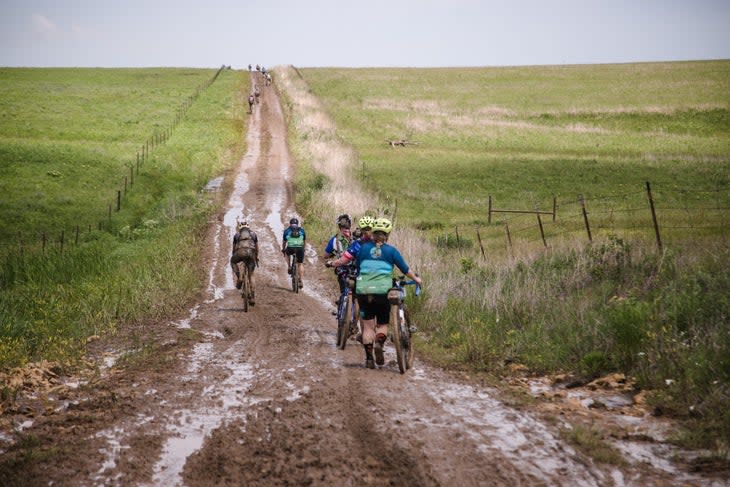
Betsy Welch (Senior editor): I have done Unbound twice – the 200 in 2019 and the XL in 2022. I did not flat either time, and while I should give more credit to my tires, I actually believe it’s because of how I rode. I had been forewarned in 2019 not to bomb through the countless dry wash/water crossing/punchy dips. I think riding those conservatively saved me; that’s where I saw dozens of people pulled over fiddling with their tires.
That said – I fell deeply in love with the Schwalbe G-One RS during XL last year. I played it safe with a 45c (I was going for comfort not speed), but that tire in a 40 or 42 would be perfect for the 200.
Other good options are the Donnelly EMP, Specialized Pathfinder Pro, and Panaracer Gravelking. You don’t need a bunch of knobs for Unbound, just bomber sidewalls!
Alvin Holbrook (Tech editor): Based on pouring through photos of folks having ridden Unbound previously, I would say the three most popular gravel tires at Unbound will be the Specialized Pathfinder Pro, Panaracer Gravelking SS+, and Vittoria Terreno Zero. The first two offer decent sidewall protection and a wider 42 or 43 mm tire width, a popular width range amongst Unbound regulars. The 38 mm Terreno Zero is a particularly fast-rolling choice that measures closer to 40 mm or more in the real world.
Pros will more often than not ride what they’re sponsored by but expect to see more of the highly-regarded Schwalbe G-One RS in a 40 mm or 45 mm this year. I’m sure more folks would ride those if they weren’t so hard to find at the moment as it is regarded as one of the fastest gravel tires available.
Either way, the best gravel tire for Unbound will likely have a semi-slick or file tread. Ideal tire width should be around a 42 mm or more measured width and a 40 mm labeled width as a minimum. Additionally, expect to see lots of elite riders using some sort of tire insert for greater sidewall support. That flint doesn’t mess around.
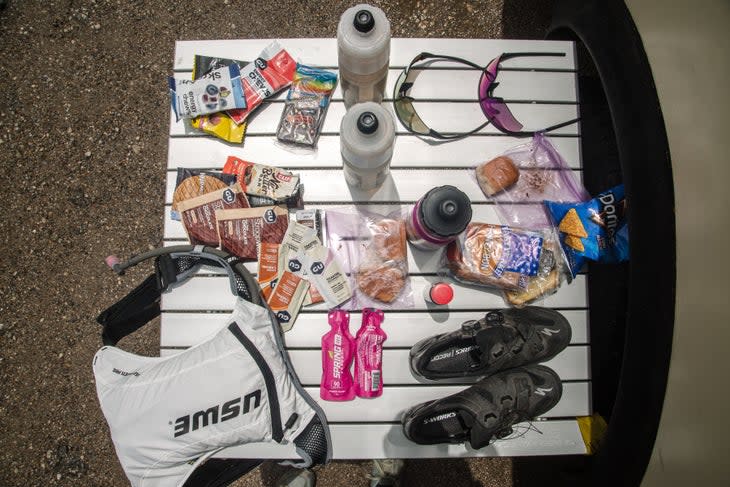
What should I bring for such a long event like Unbound 200?
TT: I would say this is completely up to each rider but remember this is a self-supported event. Sure, you might have someone at the aid station, but the distance between each is a long way, so be realistic about the time it will take to get to each aid stop. Have a goal time and breakdown each stop, but also have a “slow time” that you think you can achieve even if things aren’t going as planned. I would have a few tire boots, a tubeless repair kit (plugs of some sort), and then a spare tube along with a fast way to air up (co2), as well as a hand pump. At each aid station, it is nice to have another full kit of each and extra in case you need to use any of it. A very common occurrence at Unbound is a tear rather than a puncture. This is best remedied with a fresh tire, so it might be nice to have one at each aid station with the supplies to make the swap.
Obviously, fuel and hydration are key, making sure you have a plan, and you stick to it the best you can. Planning this with time as the default, not distance, is also key. Then no matter what your pace, you are staying on track with how often to eat and drink. As the day goes on, use your aid station supplies to adjust for changes to your planned pace. Remember also to watch your elapsed time so your finish time matches the time you have been calculating. Stopped time should be calculated into your goal time. If all else fails, have fun.
WT: It might be muddy this year, so one cheap last-second addition to your kit should be wooden paint mixing sticks found at any hardware store. Keep a few in reach on the bike, whether in a frame bag or taped to the frame, so that you can quickly scrape away any mud with little risk of damaging your bike. Extras are a good idea in case one breaks. In a pinch? Popsicle sticks are on the thin side but get the job done.
Pros can't use aero bars anymore, but the rest of us can. I see nothing wrong with them for a non-technical, super-long event like Unbound. Just refrain from using them while in a group, please; there's plenty of draft behind other riders to stay in the drops or hoods.
When it comes to tire plugs, speed is your friend. Plug a leak fast enough and you won’t need to waste more time airing up tires. Rather than shoving them inside a bag, many pros tape tire plugs all over their bikes for quick access. Securing them to brake housing with electrical tape is a common move.
Oh, and a tire boot (a proper one, not a dollar bill or energy bar wrapper) is another small, cheap addition to your flat kit that might save your day.
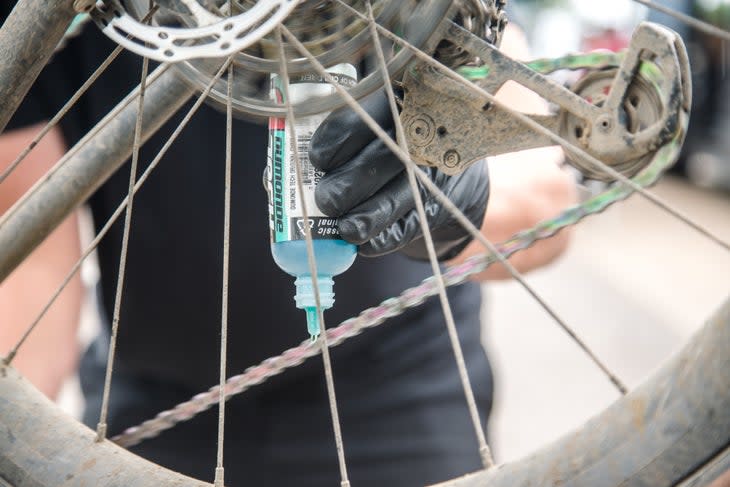
BW: Again, my best advice comes from my own experience. In 2019, my boyfriend and I didn’t arrange a support crew (we’d done plenty of epic rides before and figured we’d be fine) and then found ourselves scrambling. The crew-for-hire option was sold out, so we hastily bought hydration packs at the expo. It wasn’t enough. I ended up filling up from a farmer’s hose at one point, and at the second checkpoint, someone took pity on me and gave me a coke, chips, and cookies. You have to have some support at Unbound – whether it’s a crew at the checkpoints OR you self-support with frame bags where you can store extra snacks and water. And by snacks, I mean some real food like chips and cookies and nuts and PBJ and rice cakes.
Also – wear the shoes, sunnies, helmet, and kit you already know and love. 200 miles is no time to experiment with something you bought at Merchant Cycles or the expo.
AH: A cycling computer with the course loaded is about as mandatory as it gets. Add a few CO2 cartridges and a mini pump in case those run out as well as a pair of tire levers and a multi-tool. Tire plugs are essential here in my eyes. While I am less brand-conscious with the above suggestions, I am partial to Dynaplug’s ‘stick it in and go’ use over other options.
Obviously, bring lots of food and water. Some folks like a bar bag or mini frame bag, but I find a top tube bag (especially one with a magnetic closure) is the easiest way to get at gels, chews, and whatever I need to eat while riding. Most people are texture and taste-sensitive, particularly over long periods; I try to get my carbs, calories, and bits of nutrition as much as possible through drinks. That means I’ll using have one bottle with a standard hydration mix and another bottle with a high-carb mix. The latter isn’t for everyone but it gives me one less thing to consider so I can just keep pedaling.
Considering just how long 200 miles of gravel is, a hydration vest makes a difference both in how easily one can access water but also in how far one can ride before stopping.
And uh, maybe bring a support crew. The vast majority of people won’t have this luxury, but long distances drain you so much that making smart decisions about nutrition is no longer a given. Having a strategy and people to assist you at those few stops makes a huge difference, and they can bring you real food. After hours of drink mixes and chews, comfort food can revive you.
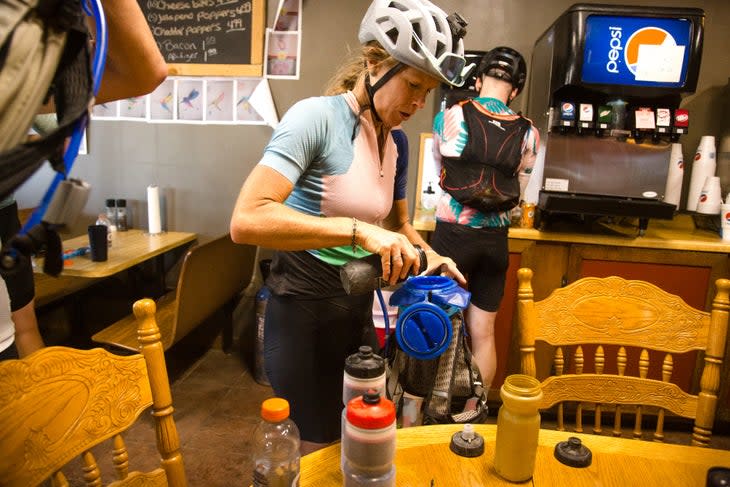
For exclusive access to all of our fitness, gear, adventure, and travel stories, plus discounts on trips, events, and gear, sign up for Outside+ today.

